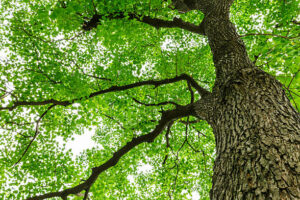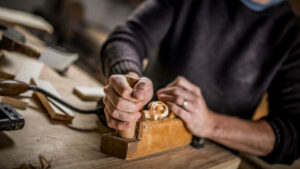Wood grain is one of the most unique and beautiful characteristics of wood grain refers on each piece of wood. From straight lines to swirling patterns, there are many ways that wood grain can appear. It is often easier to determine the slope of a wood grain on a rectangular stock without considering the open grain at its longitudinal corners. This is known as a pick test. This article will discuss the different types of wood grains available and the peculiarities that come with them.
Straight Grain
Straight-grain wood features fibers that run in a single direction, parallel to the tree’s trunk. When sawed, it will cleave cleanly and will plane or machine well with minimal tear-out. This wood is ideal for pieces that require a clean and consistent appearance, such as tabletops, furniture, or flooring.
The opposite of straight grain, wavy or curly grain features wood that appears to have undulating waves. At the same time, not as common as flat grain, wavy or curling wood is prized for its unique appearance. It is often used for accent pieces or decorative elements that add visual interest to a piece.
An interlocked or ribbon stripe figure is a type of wavy or curly grain that displays alternating directions of the spiral pattern, such as right-hand and left-hand swirls. This figure is most commonly found in white oak, walnut, and maple trees.
Closed or even grain wood has no visible grain pattern, which gives it a sleek, subtle appearance that works well in modern design and clean environments. This wood can be found in species such as maple, red oak, cherry, and holly.
Irregular or figured grain describes woods that have a pattern other than straight, which can be visually stunning and is often a result of natural growth patterns in the longitudinal cells and ray cells. Regardless of their beauty, these woods can be more challenging to work with as the irregular arrangement of closed grains can make them prone to splitting, cracking, and tearing when cut or worked.
Grain slope is the degree of variation in grain direction across a piece of lumber, with a lower gradient making it easier to work and produce more uniform results. A higher slope will require more skill and care when working with wood with an irregular vertical grain or pattern. Ultimately, this type of wood can be more difficult to finish because of the uneven takeup of paint or stain. Moreover, the changing grain direction can cause the wood to become weaker and more prone to warping over time.
Wavy Grain
The wavy grain of wood occurs when fiber groupings spiral up and down the plank’s face, producing a series of alternating straight and curved lines. This pattern creates a distinctive aesthetic that can add a sense of movement and character to the wood, and it is particularly striking when cut in a radial or tangential direction. It is most often seen in maple, and it is sometimes known as a fiddleback or curly figure. Other examples include bird’s eye, tiger stripe, and quilt figuring. This type of figured wood is not uncommon, but it is typically found in species with fine grain and little to no sapwood.
The cause of wavy grain is not completely understood, although it may be the result of a combination of factors, including tree age, growing environment, and genetics. Often, wavy grain can be found at the union of grafts, and some researchers suggest that it may be a marker for disease resistance (Conrad 1988). This figure also occurs in naturally-growing A. pseudoplatanus trees in some areas of the world, and it can be observed at high frequency in radial sections of grafts with unrelated parentage, as well as in tissue-culture propagated wood
In general, this figure is not recommended for use in exterior projects since the alternating straight and wavy lines make it more susceptible to fungal decay than other types of lumber. However, it can still be used for interior applications, such as furniture making or indoor flooring.
While wavy grain can be a beautiful addition to any piece of lumber, it is important to understand its limitations and the risks involved in working with this material. Grain slope is a crucial factor to consider when working with this wood, as a higher slope or coarse grain can be difficult to work and can decrease a board’s strength and durability. In addition, the directional shifts in the grain can make a board more prone to warping and bending.
Irregular Grain
Wood granularity doesn’t just offer aesthetic characteristics; it also affects how the material feels to the touch. Wood textures can differ depending on the arrangement, size, and frequency of a wood species” pores. This can create a coarse texture or one that feels smooth and glassy (often called fine texture).
While most people know the basics of wood grain patterns, it’s important to note that there are variations in grain pattern and direction, as well as color, appearance, and workability. Each type of grain offers unique attributes to its owners, and choosing the right wood for your project is an essential step in crafting a successful result.
Spiral Grain
As its name suggests, spiral grain occurs when tree fibers grow in a twisted or curved fashion around the trunk. While this may seem jarring, the result of closed grain is often visually appealing and can add character to any project.
Wavy Grain
When longitudinal cells don’t grow straight but weave in and out of parallel, a wavy wood grain is formed. This type of grain is common in knots, burls, and large branches that separate from the trunk (known as crotch wood). Wavy wood grains can produce a wide variety of figures, including curly, quilt, mottle, and blister.
Interlocked Grain
Taking the spiral concept a bit further, interlocked grain develops when spiral-grained trees switch directions and spiral back and forth throughout the trunk, alternating between right-hand and left-hand swirls. This shift in direction can be seen as the clearest on quartersawn surfaces, where it produces a ribbon stripe figure. Both spiral and interlocked wood grain types offer a unique look but can present challenges during machining.
Figured Grain
Figured wood is a beautiful and exotic type of hardwood with unique patterns that can add visual interest to a piece. While working with figured wood can be challenging, it also provides an opportunity for creative expression and is highly prized by many woodworking enthusiasts and artisans. Figuring is the term used to describe a combination of color, grain, and luster on a side-grain surface of hardwood species and may be a result of several conditions or defects in a particular species of wood, such as crotch, ray fleck, spalting, bird’s eye, blister or quilt, curly, tiger stripe and fiddle back.
Figured grain occurs when the longitudinal and ray cells of the tree grow in unusual patterns. These wavy lines are known as chatoyance and create patterns that appear to move when light is reflected off the wood’s surface. Chatoyance can be found in both closed-grained woods and open-grained timbers, although it is more often seen in open-grained wood, such as mahogany or walnut, due to the contrast between the pores and the lighter summerwood of these species.
In addition to the variation in grain pattern, figured wood can be differentiated by the angle at which it is cut. When the angles at which the growth rings meet the surface of the wood are close together, it is described as flatsawn; when the angles are at a higher level, the lumber is described as quartersawn, and when they are perpendicular to the surface of maple wood, it is called riftsawn.
A final type of figured grain is the swirling, twisted patterns that are sometimes found in larch or horse chestnut. These twisted fibers are sometimes known as pommel or peanut figuring and, when seen in flat-sawn pieces, end grain that can be very dramatic.






